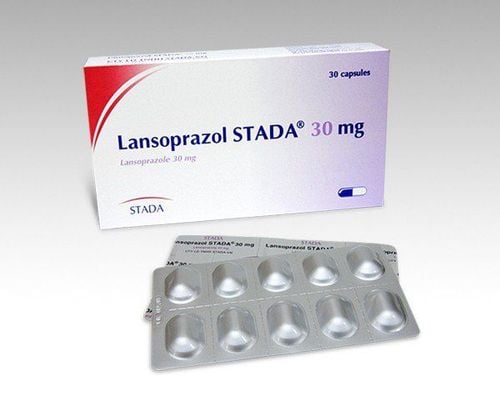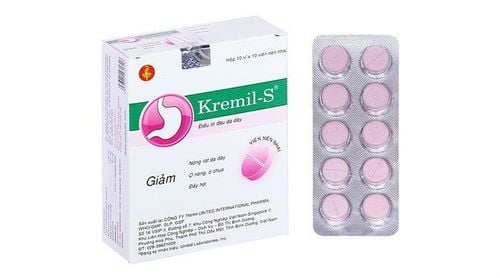This is an automatically translated article.
Peptic ulcer and gastroesophageal reflux disease are two very common diseases, causing a lot of discomfort for patients. At this time, the patient needs to use drugs to help quickly improve the symptoms of the disease, one of which is Alumag S. So what is Alumag-S?1. What is Alumag-S?
Alumag S drug includes the main active ingredients: Aluminum Hydroxyd Gel, Magnesium Hydroxyd Gel and Simethicone, which belongs to the group of drugs for the treatment of digestive diseases. Alumag S is a product manufactured by Agimexpharm Pharmaceutical Joint Stock Company, the drug is prepared in the form of an oral suspension with the following active ingredients and concentrations:
Aluminum hydroxide: 4,596g; Magnesium Hydroxide: 2,668g; Simethicone: 0.266g.
2. What are the effects of Alumag S?
Drug Alumag S is indicated for treatment in the following cases:
Acute peptic ulcer; Chronic peptic ulcer disease; Gastroesophageal reflux .
3. Pharmacological characteristics of Alumag S
3.1. Pharmacodynamics Alumag S is a combination of aluminum hydroxide, magnesium hydroxide and simethicone, thereby helping to increase the effect of the protective membrane of the stomach and duodenum. Accordingly, the individual effects of each active ingredient are described as follows:
Simethicone's use is to break up air bubbles through the reduction of surface tension, thereby assisting against bloating and indigestion. ; Aluminum hydroxide and magnesium hydroxide have a stimulating effect on increasing the pH of gastric juice, thereby inhibiting the proteolytic effect of pepsin. This mechanism plays a very important role in patients with peptic ulcer disease. In addition, these two active ingredients are often combined with each other for the purpose of supporting each other to eliminate each other's side effects on the digestive system (aluminum hydroxide causes constipation, magnesium hydroxide causes diarrhea). 3.2. Pharmacokinetics Active aluminum hydroxide dissolves slowly in the stomach, reacts with hydrochloric acid (HCl) in gastric juice to form aluminum chloride and water. Approximately 17 to 30% of the aluminum chloride formed from this reaction is rapidly absorbed and eliminated by the kidneys in subjects with normal renal function. However, in cases of renal failure when using aluminum hydroxide can occur accumulation phenomenon, usually occurs in the bones and central nervous system, thereby causing aluminum toxicity. In the small intestine, aluminum chloride is rapidly converted to an insoluble alkaline aluminum salt with poor absorption, so it is eliminated in the feces.
Aluminum hydroxide used concurrently with phosphate will react and form aluminum phosphate insoluble in the intestine, then excreted in the feces. In people with a low phosphate diet, the use of gastric antacids containing aluminum will reduce phosphate absorption, resulting in hypophosphatemia and decreased urine phosphate.
Magnesium hydroxide in the drug Alumag S, after taking it, reacts quickly with gastric hydrochloric acid to form magnesium chloride and water. This active substance is usually excreted in the feces as an insoluble magnesium salt. Small amounts of magnesium hydroxide derivatives can be absorbed and excreted in the urine.
4. Dosage and how to use Alumag
4.1. How to use Alumag S is taken orally at the following times:
Between meals; After meals from 30 minutes to 2 hours; Evening before going to bed; When there are symptoms of peptic ulcer or gastroesophageal reflux disease. 4.2. Dosage Dosage of the drug Alumag S:
Children: Take 1⁄2 sachets/time, 2-4 times/day; Adults: Take 1 sachet of Alumag S each time, 2-4 times/day. The above dosage of Alumag S is for reference only. The specific dosage depends on the condition and severity of each specific case. Therefore, to bring high efficiency and safety, patients need to consult a doctor or medical professional before using Alumag S.
4.3. Overdose and management Common symptoms of Alumag S overdose include diarrhea caused by the effects of soluble magnesium salts on the intestinal tract; When an overdose occurs, the patient should discontinue Alumag S and seek appropriate symptomatic treatment.
5. Side effects of the drug Alumag S
During the use of Alumag S, patients may experience unwanted effects (ADRs).
Related to common aluminum hydroxide is constipation. High doses and prolonged use of aluminum-containing products will interfere with the absorption of phosphate, thereby leading to the risk of osteoporosis and osteoporosis. Commonly associated with magnesium hydroxide is diarrhea. Patients with impaired renal function when using Alumag S may experience hypermagnesemia.
6. Some notes when using Alumag
Alumag S is contraindicated in the following cases:
Children under 3 months old; People who are hypersensitive or allergic to the ingredients contained in Alumag S. Caution in the process of using Alumag S with patients:
Renal dysfunction; Are taking at the same time with drugs that can cause interactions; Children under 1 year of age only take Alumag S in case of necessity; The effects of Alumag S on the ability to drive and use machines have not been observed; Pregnancy or lactation: Can be used for these subjects but should not be used in high doses for a long time.
7. Drug Interactions of Alumag S
Concomitant use of Alumag S with the following drugs may interfere with their absorption and reduce their effects:
Quinidine; Captopril; Gabapentin; Sucralfate; Digoxin; Iron-containing preparations; Isoniazid, phenothiazines, tetracyclines; Fat-soluble vitamins, especially vitamin D.
Please dial HOTLINE for more information or register for an appointment HERE. Download MyVinmec app to make appointments faster and to manage your bookings easily.













